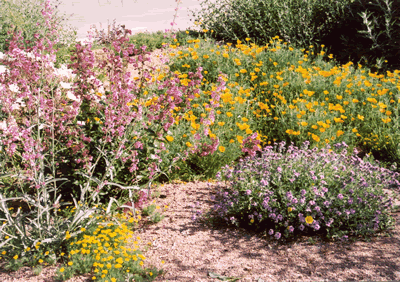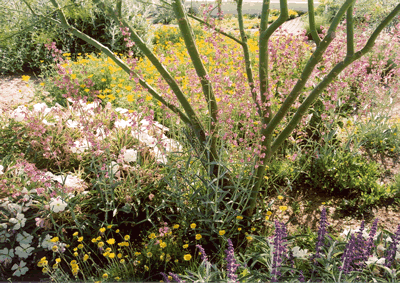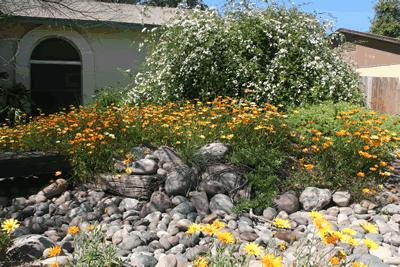Growing Desert Wildflowers
Our surrounding native desert is being gobbled up by development at the astounding rate of one acre every hour! You can help recreate these wild spaces right in your own yard by planting desert wildflowers. They remind us of our desert heritage and provide a haven for native birds and butterflies. Many wildflowers make excellent cut flowers to be enjoyed indoors as well. Wildflowers are fun and easy to grow. They are adapted to our soil, tolerate our sun and heat, and require little water. Fall is the time to plant your seeds for a spectacular display in the spring.

Photographer: Bob Bradley
Popular varieties of wildflowers to try are: Mexican Gold Poppy; California Poppy; Toadflax (wild snapdragon); Red or Scarlet Flax; Desert Lupine; Owl’s Clover; Penstemon; Bluebells; Baby Blue Eyes; Tidy Tips; Arroyo Lupine; Verbena; Desert Marigold; Evening Primrose; Mexican Hat; Shirley Poppy; Phacelia; Blanket Flower; Dyssodia; etc.
Here are some tips to ensure your success.
| • | Look for sunny locations. You will need a minimum of eight hours of sunlight for good blooming. Avoid poorly drained or heavily compacted soils. |
| • | Make sure you select a site close to a water source. If we don’t receive rain, you will need to water your seeds and seedlings to ensure a good display. You’ll need to keep the soil moist for up to three weeks or until the seedlings emerge. This may mean watering every two or three days, depending on your soil type. A simple no-hassle solution would be to sprinkle seeds in the wetting patterns of your drip emitters. |
| • | A decomposed granite landscape is an ideal medium for wildflowers. Simply sprinkle your seeds and hose them down into the granite to create a seed-to-soil contact and to protect them from hungry birds. If you are sowing seed in soil without granite, simply loosen the top inch of soil with a hard rake or cultivator to create niches for the seed. Remember that the deeper you cultivate, the greater the potential for stirring up dormant weed seeds. |
| • | Before sowing your seeds, mix them with filler such as old potting soil or clean sand to help you distribute them evenly. Mix at a ratio of four parts filler to one part seed. Sow half the seeds as uniformly as possible in a north-to-south direction, and the second half east-to-west. This will ensure an even distribution. Hose them into the granite or press them into the soil with the back of your rake. |
| • | Do not bury your seeds any deeper than 1/8th of an inch. Some of the seeds will remain visible on the soil surface. Remember that seeds not only need moisture, but light as well for germination. |
| • | If you know the area you are planting has previously produced weeds, then sow a few of your wildflower seeds in a pot of sterile potting soil. That way you will have samples to take out to your wildflower patch to help you identify your flowers from the weeds. Be sure to weed early and often. |
| • | Thin out thick stands of seedlings to no more than one every six inches. You will be glad you did when it comes to blooming time. Otherwise your flowers will compete for moisture and nutrients and may become rangy and leggy. |
| • | How often you need to water will depend on rainfall and your soil type. The key is to keep the soil moist until your seedlings emerge. When they reach one or two inches in height, water only when you see signs of stress such as wilt or yellowing. |
| • | There is no need for fertilization unless the area is depleted of nutrients or is over-planted. Desert wildflowers are adapted to our soils. Fertilizing can produce lush foliage at the expense of the blooms. If you must fertilize, use a low-nitrogen fertilizer high in phosphorous. |
| • | If you are planting native wildflowers, they should reseed easily in your landscape. Allow two weeks after the full bloom period has passed for the seeds to mature. You can allow them to reseed freely in your landscape or collect them in a paper bag to share with a neighbor or sow in another area. |

Photographer: Bob Bradley
| • | Remove the spent annuals either by pulling or cutting to ground level. Cutting to the ground level will keep soil disturbance to a minimum, preventing dormant seeds from being exposed. Cutting will also allow the roots to decompose in the soil providing nutrients and aeration. Cut back perennials for fresh growth. |
| • | Birds are attracted to freshly seeded wildflower areas. Bird netting is easy to use in areas that are small. Another method is to spread a mulch of dried leaves or shredded palm fronds over the bed. When using mulch, check every few days for emerging seedlings and be sure to remove the mulch as soon as the seedlings appear. |
For more information about growing wildflowers, contact the Desert Botanical Garden plant hotline at 480-941-1225.

Photographer: Kathleen Moore
Dimorphotheca spp.
Note: The popular wildflower African Daisy (Dimorphotheca spp.) is not recommended in areas where other native wildflowers will be seeded. Its aggressive nature overpowers the natives as it out-competes them for water and nutrients. Some consider it to be invasive.
Catherine Rymer
Water Conservation Specialist
Town of Gilbert
Compiled with assistance of Michelle Rauscher, Horticulturist who established the Wildflower Trail at the Desert Botanical Garden.